Recent Water Damage Posts
Safe Cleanup of Water Leaking Into Light Fixtures
12/5/2022 (Permalink)
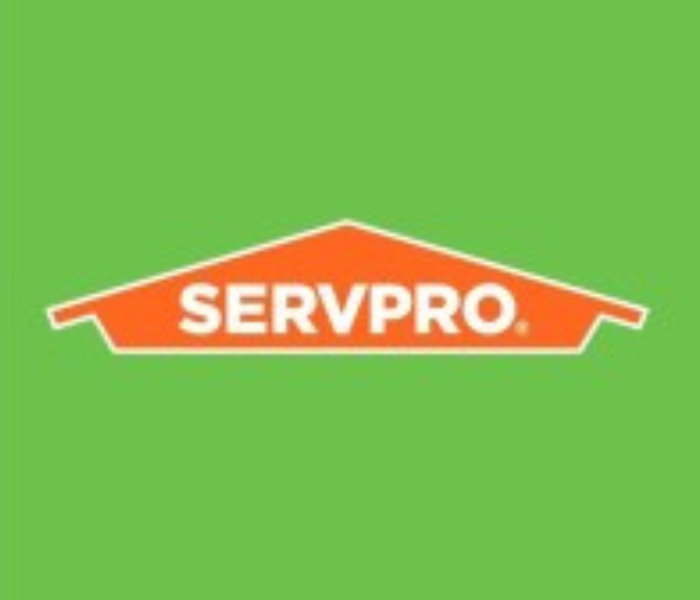 If you do find water in light fixtures in your home, take it as a serious hint that some repair and cleanup are needed.
If you do find water in light fixtures in your home, take it as a serious hint that some repair and cleanup are needed.
It is not uncommon to find water in light fixtures, or even ceiling damage following a winter with a heavy snow load, or a series of rainstorms. This damage may not always be a major problem, but could definitely develop into such if allowed to continue.
Leaks of this nature may come from a leaking flange around a chimney or vent on the roof which has developed a gap, infiltration by birds or squirrels, or from an aging roof. It may also come from an overhead pipe that is leaking due to settling, loosening of joints, or freezing temperatures. Finding and repairing the point where water is getting in is important and should be given priority attention.
How To Handle Cleanup
In order to prevent worsening damage from the water leaking through the roof, immediate cleanup needs to take place.
The attic space should be inspected to see if the insulation has become saturated. Not only can that put an excess load on the ceiling, but it can also develop mold if left alone. It may need to be removed and replaced.
If the leak is from a pipe running above the ceiling, be sure to shut the water off as soon as possible to stop the leaking.
If you find water in light fixtures, shut off the electricity to all affected fixtures before attempting to inspect or replace it, and do not turn the electricity back on until certain all water has stopped leaking.
Get Professional Help
Call a water damage cleanup specialist like SERVPRO of Southwest Orlando, to evaluate any ceiling damage and make a plan for repair. They can determine which materials need to be replaced, ensure that any mold is cleaned and removed, and restore your home to a safe condition.
If you do find water in light fixtures in your home, take it as a serious hint that some repair and cleanup are needed. This will help prevent a worse scenario and help you get your home restored to a safer and healthier condition.
4 Steps to Take Immediately After Your Pipes Burst
11/2/2022 (Permalink)
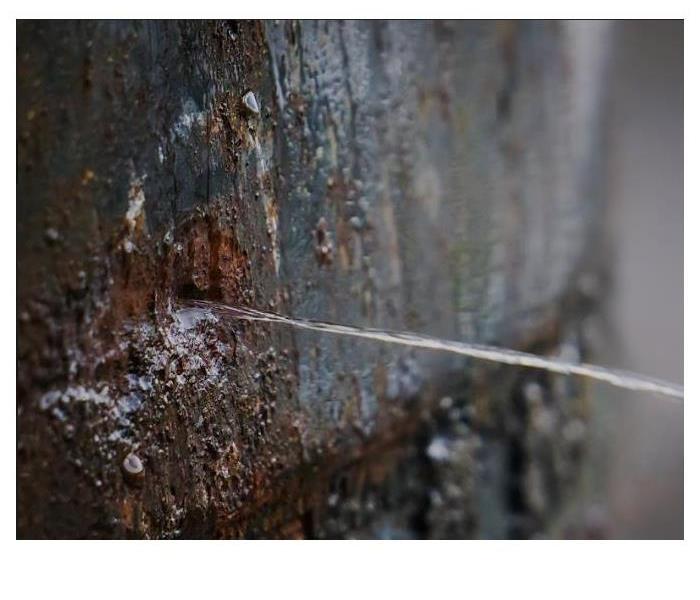 A leaking pipe can cause flooding, so it's important to cut off the water source before you do anything else.
A leaking pipe can cause flooding, so it's important to cut off the water source before you do anything else.
4 Steps to Take Immediately After Your Pipes Burst
If you're reading this article, chances are that your pipes have burst. Pipes bursting is a nightmare scenario for homeowners, but it doesn't have to be the end of the world. The first step in taking care of a burst pipe is to shut off water and power lines, which will prevent further damage from occurring until you can get help from professionals. After that, it's important to contact your insurance company and hire a restoration firm so they can ensure you're getting the best possible service at an affordable rate.
1. Shut off the water supply
The first step to repairing the damage caused by a bursting pipe is to turn off the water supply. A leaking pipe can cause flooding, so it's important to cut off the water source before you do anything else.
To shut off your home's main valve, look for a large valve that looks like two levers on opposite sides of each other. It will most likely be located in your basement or crawlspace beneath where you expect the burst pipe to be. If you're not sure about where this is or are unable to turn off your home's main valve, it may be time to call in an expert for assistance!
2. Shut off your power
Water and electricity do not mix. To keep yourself and others on your property safe following a pipe burst, is it important to shut off the power to your home or business. If you don't know how to turn off the power at your home, call an electrician. It's important that you do this before touching anything else in the house.
3. Contact SERVPRO
Now that you've taken care of the immediate situation, it's time to start making plans for how you're going to restore your home and get back on track. To do this, it's important to contact a professional water damage restoration company. They have the equipment and expertise needed to get the job done right—and they can also help you get your home back to normal as quickly as possible.
4. Check your home insurance policy
Finally, it's important to check your home insurance policy. If you have one, consider how much coverage it provides for water damage and what any deductibles are and begin the claims process. Restoration professionals, such as the professionals at SERVPRO, will take care of the entire claims process for you.
If you don't have home insurance, consider getting it before the next big one hits!
Pipes do burst, but you can take steps to minimize the damage and deal with the crisis quickly and effectively.
It's important to understand that a burst pipe is not only a serious problem, but it can also be an expensive one. In fact, according to Flood Insurance Rate Maps (FIRMs) data, about half of all homeowners affected by flooding lose more than $10,000 worth of property damage — including their homes and belongings.
The good news is that most of these losses could've been prevented had homeowners taken proper precautions before the pipes burst. By following our steps below for what to do after your pipes burst in your home or business, you'll be able to minimize any damage caused by this unfortunate event and get back on track as quickly as possible.
How to Clean Your Building After a Toilet Flood
6/16/2022 (Permalink)
There may not be much that is nastier to deal with than a sewer backup, and your business plan may not include the budget for a sewer cleanup, so, it might be worth looking into flood insurance. Nonetheless, problems can occur and the unexpected can happen, throwing a wrench into the works. Differing from a category 1 or clean water flood, a flooded toilet carries serious contaminants that must be properly dealt with.
How Do You Clean Up Sewer Water
If the water is running clear, stops upon shutoff, and is confined to a non-porous bathroom floor, you may be able to mop it up and clean it with detergent and chlorine bleach. If the water has any color to it, is coming from deeper in the drain or is spilling out onto carpeted areas, down a heat duct, or is deep enough to be standing you will likely need assistance from a professional sewage cleanup service.
Remove everyone from the area to avoid exposure
Find the water shutoff valve and turn the flow off, if possible
If the water is not running mostly clear, it may be coming from the sewer rather than the supply line
Water must be extracted and cleaned up
Sanitizing and disinfecting must be thoroughly done as sewage can be considered a biohazard
Cleaning and Disinfecting
The sewer line may need to be cleared professionally to unblock the drain. A sewer cleanup service may be necessary to help with that as well as the cleanup. Sewage water is likely to contain bacteria and viruses and it is critical to contain the spill and begin professional a sanitizing process as soon as possible, using industrial disinfectants. Every nook and cranny needs attention. Any rugs, carpets, or soft surfaces will likely need to be disposed of.
Employ preventative measures such as regular drain and supply line inspections and enzyme treatments to reduce the risk of flooding. When prevention fails and the need for sewer cleanup occurs, take it seriously to ensure proper restoration.
Orlando 24 Hour Emergency Water Damage Service
6/16/2022 (Permalink)
SERVPRO of SW Orlando is available 24 hours a day for water emergencies, large or small. When you are dealing with water damage, immediate action is crucial. A delay of just a few hours can greatly increase the severity of the water damage.
We Answer the Phone Ready to Help
Call Today - (407)704-0327
We understand that when you call us, you may be feeling confused, stressed, and vulnerable. You need an expert to guide you through this crisis. SERVPRO of SW Orlando has the specific water damage training and experience to help you through this tough time. We specialize in water damage restoration—in fact, it's the cornerstone of our business.
What to Expect
When you call, we will ask several questions regarding your water damage emergency. These questions will help us determine what equipment and resources to bring, including how many trained SERVPRO Professionals may be needed.
Our SERVPRO Representative will ask several questions:
- Your name and contact information
- Your insurance information (if applicable)
- The street address of the water-damaged home or business
- When did the flooding or water damage occur?
- What caused the water damage (if known)?
- Is there electricity available (on-site)?
About SERVPRO of SW Orlando
SERVPRO of SW Orlando specializes in the cleanup and restoration of residential and commercial property after a fire, smoke, or water damage event. Our staff is highly trained in property damage restoration. From initial and ongoing training at SERVPRO’s corporate training facility to regular IICRC-industry certification, rest assured our staff is equipped with the knowledge to restore your property.
Dealing with Water Damage
5/18/2022 (Permalink)
Dealing with water damage can be unexpected and frustrating. If you or someone you know has had water damage give us a call. We are always here to help. Water damage can be caused by numerous things. Some of those things are listed below.
- Toilet overflow
- Water supply line break
- Roof leak
- Flooding
- Fish tank break
- AC Leak
- Fridge Leak
- Water Heater Leak
- Slab Leak
Many things can cause water damage. Call us if you have any questions.
SERVPRO of Southwest Orlando is a Florida State licensed Certified Building Contractor, Mold Remediator, and Mold Assessor. We are IICRC (Institute of Inspection Cleaning and Restoration Certification) certified in Fire/Water/Mold clean-up & restoration. Call us today, we are always here to help.
3 Steps To Take When There Is Water In Your Crawl Space
2/17/2022 (Permalink)
Crawl spaces are often overlooked by homeowners until there’s a flood and they are forced to investigate. These areas are usually located between the ground and the first floor. Many homeowners struggle with entering crawl spaces, which are only several feet high. What you do not want to find is water in these spaces. These three safety tips are essential for ensuring that all water is removed from your home after heavy rainfall.
1. Locate the Source of a Flood
A wet crawl space is a result of water entering your home in an undesirable way. The following might cause this frustrating problem:
- The poor foundation of the building
- Malfunctioning downspouts and gutters
- Ruptured water lines
- Excessive subterranean water
It’s important to at least make an educated guess about what caused the flooding so that you can do everything you can to not make it worse. If you suspect a broken pipe, for example, it’s wise to avoid your shower, sinks, and toilet until your wet crawl space is clean.
2. Consult With the Experts
Orlando, FL, has many companies that specialize in residential water issues. Ideally, you want to trust water damage experts that are experienced and trained. They should be able to look over your property and know exactly what to do to make it as good as new. Repairs can be an extensive process, so patience and faith in a company are key.
3. Waterproof Your Crawl Space
Nobody can control the weather. Waterproofing your crawl space is an excellent way to get peace of mind when the clouds start to gather and you think your home might be the target of a natural disaster. There are many waterproofing techniques ranging from applying a sealant to your home’s foundation to installing a sump pump.
The dark and muddy depths of a wet crawl space can be intimidating, especially when it's flooded. These three safety suggestions can help eliminate anxiety and simplify the clean-up process.
Here's How To Avoid Water Damage After Construction
1/28/2022 (Permalink)
Managing a construction business in Orlando, FL, is like juggling fireballs; your priorities rapidly change, and you always feel like you’re being burned. Regardless of the heat, water is not your friend here – in fact, water damage is something all new construction must deal with.
Preventing this damage is critical since at least part of the costs will be absorbed by the contractor, even on insured properties. Water pipe repair, replaced materials and added labor costs quickly add up, so anything you can do to stop damage before it occurs is to your advantage.
Pre-Construction Is the Best Chance to Prevent Water Intrusion
Before construction begins, you should create a quality assurance and quality control (QA/QC) program. A major part of that should include
- Identifying areas susceptible to water infiltration
- Building proper drainage to avoid areas being flooded.
- Sending a request for information (RFI) to the engineer about any areas of concern.
- Your Construction Company Should Have a Dedicated Quality Control Director
Any large or mid-size construction company requires needs a specific person who is responsible for developing documentation, auditing, and improvement of all ongoing projects. They’re responsible for inspections and continually revise the plan as needed for changing conditions. They designate who will pay for damage and any necessary water pipe repair.
During construction, subcontractors should be fully aware of your QA/QC program. The director and your contract should clearly state a “no defects” policy, requiring all subcontractors to be responsible for broken pipes or creating a situation that interferes with your pre-construction planning.
Testing Your QA/QC Program
Once the roof is in place, it needs to be tested by an expert. When the plumbing has been installed, run an air pressurization test of all piping systems. When the lines are filled with water at their nominal pressure, closely monitor them for at least the first 24 hours, with one person ready for immediate water pipe repair.
If you have questions about how to protect your construction site from water damage – or have suffered storm, flood, or burst pipe water intrusion – call a top restoration company for immediate service. SERVPRO is Faster to any size disaster.
Flood Risk
8/3/2021 (Permalink)
If you’re in the process of buying a house or you’re looking for a new homeowners insurance policy, you might be familiar with what a flood zone is. If you don’t know what they are, you might want to start reading upon them.
Zoning for Floods?
A flood zone is an area in a specific geographical space that the Federal Emergency Management Agency has determined has at least some risk of flooding. There are four primary types of zones, which correlate to the severity or category of excessive water events that can occur in that area.
- Moderate to Low-Risk Areas
- High-Risk Areas
- High Risk – Coastal Areas
- Undetermined Risk Areas
How to Find Your Zone
Each area’s zones are depicted on a community's Flood Insurance Rate Map, also known as FIRM, which can be found online at https://www.fema.gov/flood-insurance-rate-map-firm. You can also contact your local municipality or look on their website, most cities will have zoning information available online. You can try searching for the term “flood elevation certificate” for faster results.
Some people may think that these zones can only be found next to a large body of water or along a river or stream, but that’s not the case. Houses that are nowhere near a body of water can experience a flood if there’s a large rainstorm.
Emergency Preparedness
Knowing what kind of flood zone you live in can also be helpful for storage options and emergency preparedness. If you live in a high-risk zone, for example, you probably don’t want to put boxes directly on the floor, and you might want to increase the number of your emergency supplies.
If you weren’t aware that your home is potentially at risk for a flood, and a storm causes water-related damage, you should contact a storm damage specialist in your area to determine your best course of action and get the damage repaired as quickly as possible.
Orlando 24 Hour Emergency Water Damage Service
6/16/2021 (Permalink)
SERVPRO of SW Orlando is available 24 hours a day for water emergencies, large or small. When you are dealing with water damage, immediate action is crucial. A delay of just a few hours can greatly increase the severity of the water damage.
We Answer the Phone Ready to Help
Call Today - (407)704-0327
We understand that when you call us, you may be feeling confused, stressed, and vulnerable. You need an expert to guide you through this crisis. SERVPRO of SW Orlando has the specific water damage training and experience to help you through this tough time. We specialize in water damage restoration—in fact, it's the cornerstone of our business.
What to Expect
When you call, we will ask several questions regarding your water damage emergency. These questions will help us determine what equipment and resources to bring, including how many trained SERVPRO Professionals may be needed.
Our SERVPRO Representative will ask several questions:
- Your name and contact information
- Your insurance information (if applicable)
- The street address of the water-damaged home or business
- When did the flooding or water damage occur?
- What caused the water damage (if known)?
- Is there electricity available (on-site)?
About SERVPRO of SW Orlando
SERVPRO of SW Orlando specializes in the cleanup and restoration of residential and commercial property after a fire, smoke, or water damage event. Our staff is highly trained in property damage restoration. From initial and ongoing training at SERVPRO’s corporate training facility to regular IICRC-industry certification, rest assured our staff is equipped with the knowledge to restore your property.
How To Clean Your Building After a Toilet Flood
6/16/2021 (Permalink)
There may not be much that is nastier to deal with than a sewer backup, and your business plan may not include the budget for a sewer cleanup, so, it might be worth looking into flood insurance. Nonetheless, problems can occur and the unexpected can happen, throwing a wrench into the works. Differing from a category 1 or clean water flood, a flooded toilet carries serious contaminants that must be properly dealt with.
How Do You Clean Up Sewer Water
If the water is running clear, stops upon shutoff and is confined to a non-porous bathroom floor, you may be able to mop it up and clean it with detergent and chlorine bleach. If the water has any color to it, is coming from deeper in the drain or is spilling out onto carpeted areas, down a heat duct or is deep enough to be standing you will likely need assistance from a professional sewage cleanup service.
Remove everyone from the area to avoid exposure
Find the water shutoff valve and turn the flow off, if possible
If the water is not running mostly clear, it may be coming from the sewer rather than the supply line
Water must be extracted and cleaned up
Sanitizing and disinfecting must be thoroughly done as sewage can be considered a biohazard
Cleaning and Disinfecting
The sewer line may need to be cleared professionally to unblock the drain. A sewer cleanup service may be necessary to help with that as well as the cleanup. Sewage water is likely to contain bacteria and viruses and it is critical to contain the spill and begin professional a sanitizing process as soon as possible, using industrial disinfectants. Every nook and cranny needs attention. Any rugs, carpets or soft surfaces will likely need to be disposed of.
Employ preventative measures such as regular drain and supply line inspections and enzyme treatments to reduce the risk of flooding. When prevention fails and the need for sewer cleanup occurs, take it seriously to ensure proper restoration.
Dealing With Water Damage
5/18/2021 (Permalink)
Dealing with water damage can be unexpected and frustrating. If you or someone you know has had water damage give us a call. We are always here to help. Water damages can be caused by numerous things. Some of those things are listed below.
- Toilet overflow
- Water supply line break
- Roof leak
- Flooding
- Fish tank break
- AC Leak
- Fridge Leak
- Water Heater Leak
- Slab Leak
Many things can cause water damages. Call us if you have any questions.
SERVPRO of Southwest Orlando is a Florida State licensed Certified Building Contractor, Mold Remediator, and Mold Assessor. We are IICRC (Institute of Inspection Cleaning and Restoration Certification) certified in Fire/Water/Mold clean-up & restoration. Call us today, we are always here to help.
3 Steps To Take When There Is Water in Your Crawl Space
2/17/2021 (Permalink)
Crawl spaces are often overlooked by homeowners until there’s a flood and they are forced to investigate. These areas are usually located between the ground and the first floor. Many homeowners struggle with entering crawl spaces, which are only several feet high. What you do not want to find is water in these spaces. These three safety tips are essential for ensuring that all water is removed from your home after heavy rainfall.
1. Locate the Source of a Flood
A wet crawl space is a result of water entering your home in an undesirable way. The following might cause this frustrating problem:
- Poor foundation of the building
- Malfunctioning downspouts and gutters
- Ruptured water lines
- Excessive subterranean water
It’s important to at least make an educated guess about what caused the flooding so that you can do everything you can to not make it worse. If you suspect a broken pipe, for example, it’s wise to avoid your shower, sinks, and toilet until your wet crawl space is clean.
2. Consult With the Experts
Orlando, FL, has many companies that specialize in residential water issues. Ideally, you want to trust water damage experts that are experienced and trained. They should be able to look over your property and know exactly what to do to make it as good as new. Repairs can be an extensive process, so patience and faith in a company are key.
3. Waterproof Your Crawl Space
Nobody can control the weather. Waterproofing your crawl space is an excellent way to get peace of mind when the clouds start to gather and you think your home might be the target of a natural disaster. There are many waterproofing techniques ranging from applying a sealant to your home’s foundation to installing a sump pump.
The dark and muddy depths of a wet crawl space can be intimidating, especially when it's flooded. These three safety suggestions can help eliminate anxiety and simplify the clean-up process.
Here’s How to Avoid Water Damage During Construction
1/28/2021 (Permalink)
Managing a construction business in Orlando, FL, is like juggling fireballs; your priorities rapidly change, and you always feel like you’re being burned. Regardless of the heat, water is not your friend here – in fact, water damage is something all new construction must deal with.
Preventing this damage is critical since at least part of the costs will be absorbed by the contractor, even on insured properties. Water pipe repair, replaced materials and added labor costs quickly add up, so anything you can do to stop damage before it occurs is to your advantage.
Pre-Construction Is the Best Chance to Prevent Water Intrusion
Before construction begins, you should create a quality assurance and quality control (QA/QC) program. A major part of that should include
- Identifying areas susceptible to water infiltration
- Building proper drainage to avoid areas being flooded.
- Sending a request for information (RFI) to the engineer about any areas of concern.
- Your Construction Company Should Have a Dedicated Quality Control Director
Any large or mid-size construction company requires needs a specific person who is responsible for developing documentation, auditing, and improvement of all ongoing projects. They’re responsible for inspections and continually revise the plan as needed for changing conditions. They designate who will pay for damage and any necessary water pipe repair.
During construction, subcontractors should be fully aware of your QA/QC program. The director and your contract should clearly state a “no defects” policy, requiring all subcontractors to be responsible for broken pipes or creating a situation that interferes with your pre-construction planning.
Testing Your QA/QC Program
Once the roof is in place, it needs to be tested by an expert. When the plumbing has been installed, run an air pressurization test of all piping systems. When the lines are filled with water at its nominal pressure, closely monitor them for at least the first 24 hours, with one person ready for immediate water pipe repair.
If you have questions about how to protect your construction site from water damage – or have suffered storm, flood, or burst pipe water intrusion – call a top restoration company for immediate service. SERVPRO is Faster to any size disaster.
Safe Cleanup of Water Leaking Into Light Fixtures
12/20/2020 (Permalink)
It is not uncommon to find water in light fixtures, or even ceiling damage following a winter with a heavy snow load, or a series of rainstorms. This damage may not always be a major problem, but could definitely develop into such if allowed to continue.
Leaks of this nature may come from a leaking flange around a chimney or vent on the roof which has developed a gap, infiltration by birds or squirrels, or from an aging roof. It may also come from an overhead pipe that is leaking due to settling, loosening of joints, or freezing temperatures. Finding and repairing the point where water is getting in is important and should be given priority attention.
How To Handle Cleanup
In order to prevent worsening damage from the water leaking in through the roof, immediate cleanup needs to take place.
The attic space should be inspected to see if the insulation has become saturated. Not only can that put an excess load on the ceiling, but it can also develop mold if left alone. It may need to be removed and replaced.
If the leak is from a pipe running above the ceiling, be sure to shut the water off as soon as possible to stop the leaking.
If you find water in light fixtures, shut off the electricity to all affected fixtures before attempting to inspect or replace it, and do not turn the electricity back on until certain all water has stopped leaking.
Get Professional Help
Call a water damage cleanup specialist to evaluate any ceiling damage and make a plan for repair. They can determine which materials need to be replaced, ensure that any mold is cleaned and removed, and restore your home to a safe condition.
If you do find water in light fixtures in your home, take it as a serious hint that some repair and cleanup is needed. This will help prevent a worse scenario and help you get your home restored to a safer and healthier condition.
Flood Risks
8/4/2020 (Permalink)
If you’re in the process of buying a house or you’re looking for a new home owners insurance policy, you might be familiar with what a flood zone is. If you don’t know what they are, you might want to start reading up on them.
Zoning for Floods?
A flood zone is an area in a specific geographical space that the Federal Emergency Management Agency has determined has at least some risk of flooding. There are four primary types of zones, which correlate to the severity or category of excessive water events that can occur in that area.
- Moderate to Low Risk Areas
- High Risk Areas
- High Risk – Coastal Areas
- Undetermined Risk Areas
How to Find Your Zone
Each area’s zones are depicted on a community's Flood Insurance Rate Map, also known as FIRM, which can be found online at https://www.fema.gov/flood-insurance-rate-map-firm. You can also contact your local municipality or look on their website, most of cities will have zoning information available online. You can try searching for the term “flood elevation certificate” for faster results.
Some people may think that these zones can only be found next to a large body of water or along a river or stream, but that’s not the case. Houses that are nowhere near a body of water can experience a flood if there’s a large rain storm.
Emergency Preparedness
Knowing what kind of flood zone you live in can also be helpful for storage options and emergency preparedness. If you live in a high-risk zone, for example, you probably don’t want to put boxes directly on the floor, and you might want to increase the number of your emergency supplies.
If you weren’t aware that your home is potentially at risk for a flood, and a storm causes water related damage, you should contact a storm damage specialist in your area to determine your best course of action and get the damage repaired as quickly as possible.
What You Need To Know About Black Water
6/11/2020 (Permalink)
If your home has experienced serious flooding, you’re probably facing extensive water damage. Flood water is considered black water, which means you will need to call in experienced remediation specialists who understand the best practices for restoration to handle the cleanup. This is because black water poses a serious threat.
What Is Black Water?
During a flood, sewers and toilets can overflow, pipes can burst and flood waters can pick up any number of contaminants as they flow through an area. This contamination with feces, urine and other dangerous pollutants are what make flood water “black.” Any stagnant water that has been around long enough to support the growth of harmful bacterial is also considered black.
Why Is It Dangerous?
Contaminated flood water carries dangerous bacteria that can cause humans and animals to become sick. This can occur from accidentally swallowing water or having it come into contact with small wounds or scratches. This includes the flood water saturating possessions after the bulk of the flooding has receded, which is why you should not attempt your own water damage cleanup. Diseases that can be caused by black water include the following:
• Hepatitis
• Gastroenteritis
• Giardia
• Campylobacteriosis
• Typhoid
• Cholera
What Should You Do About It?
Because flood water is considered black water, you shouldn’t attempt to clean your own home after a serious flood. Contact a professional remediation service to handle it for you. After its representatives have assessed the situation, they will begin the process of extracting the remaining water, disinfecting your home and drying it out with industrial equipment. It’s critical this process happens quickly to avoid irreversible damage and mold growth.
When you’re facing water damage after a flood, don’t endanger your family’s health by trying to clean it up yourself. Hire a trained professional who has the knowledge and specialized equipment to handle the damage safely and effectively.
How To Clean Your Building After a Toilet Flood
5/14/2020 (Permalink)
There may not be much that is nastier to deal with than a sewer backup, and your business plan may not include the budget for a sewer cleanup, so, it might be worth looking into flood insurance. Nonetheless, problems can occur and the unexpected can happen, throwing a wrench into the works. Differing from a category 1 or clean water flood, a flooded toilet carries serious contaminants that must be properly dealt with.
How Do You Clean Up Sewer Water
If the water is running clear, stops upon shutoff and is confined to a non-porous bathroom floor, you may be able to mop it up and clean it with detergent and chlorine bleach. If the water has any color to it, is coming from deeper in the drain or is spilling out onto carpeted areas, down a heat duct or is deep enough to be standing you will likely need assistance from a professional sewage cleanup service.
Remove everyone from the area to avoid exposure
Find the water shutoff valve and turn the flow off, if possible
If the water is not running mostly clear, it may be coming from the sewer rather than the supply line
Water must be extracted and cleaned up
Sanitizing and disinfecting must be thoroughly done as sewage can be considered a biohazard
Cleaning and Disinfecting
The sewer line may need to be cleared professionally to unblock the drain. A sewer cleanup service may be necessary to help with that as well as the cleanup. Sewage water is likely to contain bacteria and viruses and it is critical to contain the spill and begin professional a sanitizing process as soon as possible, using industrial disinfectants. Every nook and cranny needs attention. Any rugs, carpets or soft surfaces will likely need to be disposed of.
Employ preventative measures such as regular drain and supply line inspections and enzyme treatments to reduce the risk of flooding. When prevention fails and the need for sewer cleanup occurs, take it seriously to ensure proper restoration.
Possible Reasons Your Toilet May Be Leaking
5/5/2020 (Permalink)
Do You Notice Water Every Time You Flush?
You may have a leaking toilet. A buildup of standing water in your bathroom could lead to water damage, mold or mildew, so it’s best to find the source of the problem as soon as possible- especially in Kansas City, MO. As a complex system, there are multiple reasons this could be happening. Toilets are an everyday necessity, so be sure to take the proper measures to get it back in working order.
Diagnose the Problem
First you need to figure out where the water is leaking from. Clean up as much of the water as you can on both the floor and the toilet itself, so that you can follow the water as it builds again. Try flushing the leaking toilet to jumpstart the process. Usually the water seeps out below the toilet, which will be addressed below, but during this process more unusual causes may present themselves, such as a:
- Damaged toilet tank
- Valve that does not completely close
- Sweaty bowl
- Supply tube that is wobbly or movable
Tighten Up
Water pooling beneath your leaking toilet may be the result of floor bolts that hold the toilet in place becoming loose. Simply remove the protective covers and tighten each one with a wrench. Be sure not to make them too tight, or you could damage the toilet. You should visibly notice the leak stop. If not, there may be a deeper issue.
Wax Gasket
If tightening bolts did not stop your water flow, that probably means that the wax seal on your gasket is dry or cracked. Luckily, it is replaceable. Be sure to shut off the water and drain the toilet before beginning the process. Next, disconnect the water-supply tube and lift the toilet from the floor. You will need to scrape off the old wax before installing the new wax gasket.
Leaking bathrooms are no fun, but that does not mean they should be ignored. Diagnosing the problem is half the job. Feel free to reach out to a professional.
3 Steps To Take When There Is Water in Your Crawl Space
2/17/2020 (Permalink)
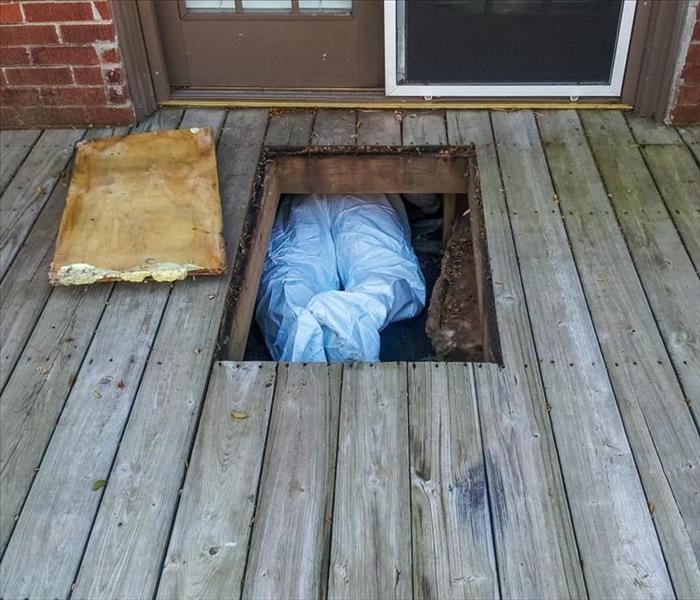 Many homeowners struggle with entering crawl spaces, which are only several feet high
Many homeowners struggle with entering crawl spaces, which are only several feet high
3 Steps To Take When There Is Water in Your Crawl Space
Crawl spaces are often overlooked by homeowners until there’s a flood and they are forced to investigate. These areas are usually located between the ground and the first floor. Many homeowners struggle with entering crawl spaces, which are only several feet high. What you do not want to find is water in these spaces. These three safety tips are essential for ensuring that all water is removed from your home after heavy rainfall.
1. Locate the Source of a Flood
A wet crawl space is a result of water entering your home in an undesirable way. The following might cause this frustrating problem:
- Poor foundation of the building
- Malfunctioning downspouts and gutters
- Ruptured water lines
- Excessive subterranean water
It’s important to at least make an educated guess about what caused the flooding so that you can do everything you can to not make it worse. If you suspect a broken pipe, for example, it’s wise to avoid your shower, sinks and toilet until your wet crawl space is clean.
2. Consult With the Experts
Orlando, FL, has many companies that specialize in residential water issues. Ideally, you want to trust water damage experts that are experienced and trained. They should be able to look over your property and know exactly what to do to make it as good as new. Repairs can be an extensive process, so patience and faith in a company are key.
3. Waterproof Your Crawl Space
Nobody can control the weather. Waterproofing your crawl space is an excellent way to get peace of mind when the clouds start to gather and you think your home might be the target of a natural disaster. There are many waterproofing techniques ranging from applying a sealant to your home’s foundation to installing a sump pump.
The dark and muddy depths of a wet crawl space can be intimidating, especially when it's flooded. These three safety suggestions can help eliminate anxiety and simplify the clean-up process.
Here’s How to Avoid Water Damage During Construction
1/27/2020 (Permalink)
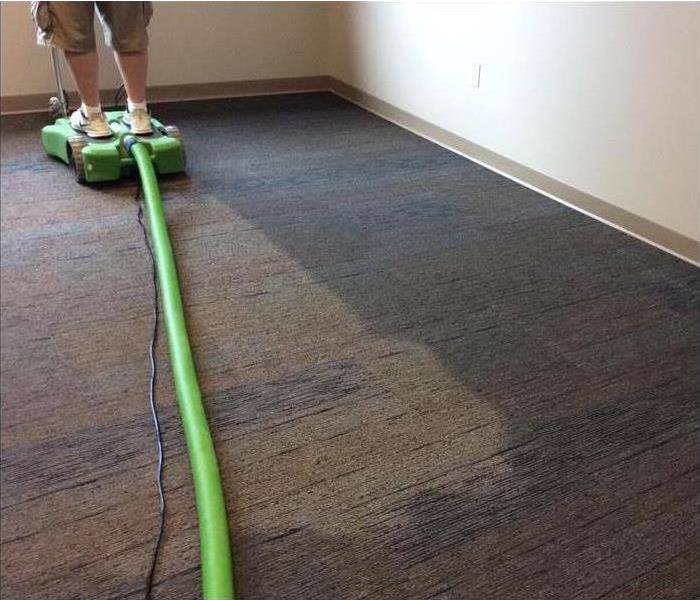 Water extraction in Orlando, FL
Water extraction in Orlando, FL
Here’s How to Avoid Water Damage During Construction
Managing a construction business in Orlando, FL, is like juggling fireballs; your priorities rapidly change, and you always feel like you’re being burned. Regardless of the heat, water is not your friend here – in fact, water damage is something all new construction must deal with.
Preventing this damage is critical since at least part of the costs will be absorbed by the contractor, even on insured properties. Water pipe repair, replaced materials and added labor costs quickly add up, so anything you can do to stop damage before it occurs is to your advantage.
Pre-Construction Is the Best Chance to Prevent Water Intrusion
Before construction begins, you should create a quality assurance and quality control (QA/QC) program. A major part of that should include
- Identifying areas susceptible to water infiltration
- Building proper drainage to avoid areas being flooded.
- Sending a request for information (RFI) to the engineer about any areas of concern.
Your Construction Company Should Have a Dedicated Quality Control Director
Any large or mid-size construction company requires needs a specific person who is responsible for developing documentation, auditing, and improvement of all ongoing projects. They’re responsible for inspections and continually revise the plan as needed for changing conditions. They designate who will pay for damage and any necessary water pipe repair.
During construction, subcontractors should be fully aware of your QA/QC program. The director and your contract should clearly state a “no defects” policy, requiring all subcontractors to be responsible for broken pipes or creating a situation that interferes with your pre-construction planning.
Testing Your QA/QC Program
Once the roof is in place, it needs to be tested by an expert. When the plumbing has been installed, run an air pressurization test of all piping systems. When the lines are filled with water at its nominal pressure, closely monitor them for at least the first 24 hours, with one person ready for immediate water pipe repair.
If you have questions about how to protect your construction site from water damage – or have suffered storm, flood or burst pipe water intrusion – call a top restoration company for immediate service. SERVPRO is Faster to any size disaster.
How Does Water Enter Your Home's Crawl Space?
12/10/2019 (Permalink)
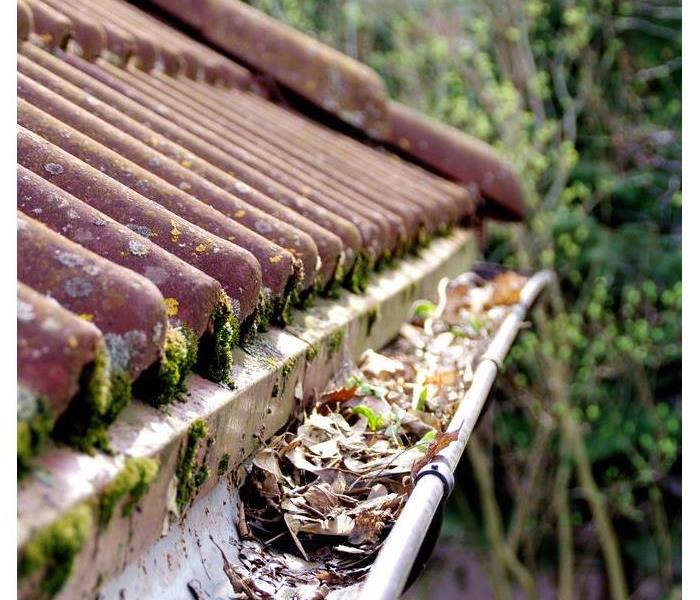 Rain gutter clogged with leaves
Rain gutter clogged with leaves
Inside your walls and under your floor boards, you have spots of open air. If water gathers there, it's hard to detect. This wet crawl space is worrisome because darkness and moisture can combine to produce mold; therefore, not only could you have damaged structure, but you might have fungus. Complicating it further is the air conditioner, picking up these spores and spreading them throughout the residence. Protect your place. Be aware of what to look for and how to correct it.
How Did Water Invade My Home?
While your home may seem tightly sealed up, it may actually have some openings, leaving your place exposed to flooding issues without you even knowing it. For example, perhaps you have a few shingles that have fallen off. If that's the case, rain water could easily sneak beyond into the ceiling, pooling up in the attic unbeknownst to you. What about a pipe in the wall? A small crevice could be releasing drips into the walls. In addition, the following reasons could create hidden moisture problems:
- Foundation issues
- Irrigation pipe problems
- Main water line leaks
- Gutters clogged with ice or leaves
- Air handler trouble
Try and pay attention to your surroundings and see if you're having changes in humidity or noticing water stains. Those could be indications that you need to check for wet crawl space.
How Do You Get Rid of It?
To remove the liquid, you'll need to fix the initial complication. That means bringing in professionals to repair any damage. Then, find a water remediation company in Orlando, FL, to evaluate moisture levels. If pools accumulated, you may be open to fungus growth or structural damage. This team of experts can dry out the area, take out any problematic sections and begin repairs. Hopefully, it will feel as if the flood never occurred.
Be aware of your surroundings, and understand how water can hide in your home. Areas such as roofs, attics and foundation levels should not be ignored, rather, they should be checked regularly. If you suspect you have a wet crawl space, call experts to dry it out and make repairs.
Immediate Steps to Take if You Suffer From Water Damage
10/28/2019 (Permalink)
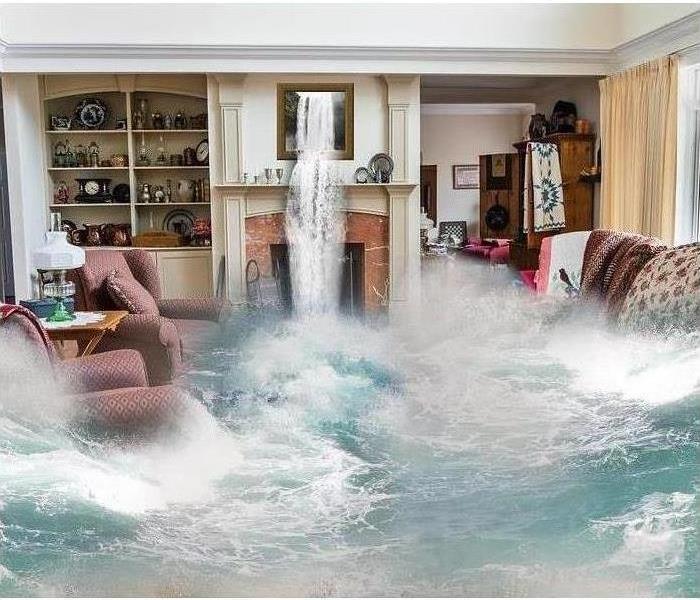 Follow these tips so you can be prepared.
Follow these tips so you can be prepared.
Let’s face it, water damage is threatening to your property’s value and can cause some serious, well damage. Whether you’re facing a storm; a flood; leaks from a weakened roof, HVAC or busted pipes; or experience overflowing appliances, water damage can wreak havoc in an array of emergency situations. To prevent further damage and to increase chances of salvation, it is critical to act quickly within the first 24 hours. Considering you have safely evacuated the premises and safety officials have declared it safe, follow these steps to immediately rectify your business from water damage.
Avoid Additional Risks
Upon returning to your property, survey the premises and document any visible structural damage that may further endanger you and your property. Look for signs of warping, loosened or cracked foundation elements, and holes. If safety officials haven’t done so already, contact utility companies to cease all water and electrical sources. Even if the power is still out upon your return, physically turn off the main power line and individual fuses to avoid risk of electrocution should the power be reactivated.
Document Everything
While surveying your property, take photos and document all damages. Digital photos will allow you to properly store, back-up and transfer files quickly and conveniently. Be sure to document all damages prior to removing any water or starting on any repairs; otherwise, you risk decreasing the extent of your insurance coverage.
Contact your Insurance Provider
Contacting your insurance provider is critical immediately following water damage and your return to the property. Your insurance provider will be able to assess the situation, file a claim, determine whether or not the damage is severe enough to send an adjuster, and provide invaluable next steps. They will also ask for the documentation you’ve collected so it’s important to have that readily available. Pro Tip: if government authorities have declared your region a ‘disaster area’, property owners may have access to increased resources, services and financial assistance.
Secure the Property
Place board over broken windows, fasten tarps, and carryout other measures to avoid further leaks and water damage. Be sure to document all of your efforts to secure your property from further damage. If these precautionary steps are not taken and something else happens, additional damages may not be covered by your insurance provider.
Mitigate Mold Damage
It only takes 24-48 hours for mold to develop following a flood or water damage. If items have been wet for less than 48 hours, they may be salvageable. Remove wet contents such as carpeting and furniture as soon as possible. If an item has been exposed longer than 48 hours, it may be harder and more expensive to salvage. If possible, you can start the drying out process within 24 hours and eliminate mold and mildew growth by:
- Removing wet furniture or lifting it off of carpet
- Place aluminum foil or other carpet separators on furniture to prevent carpet stains
- Remove and hang area rugs to dry
- Use fans and dehumidifiers to dry out wet areas
- Turn air conditioning on to help remove humidity and speed the drying process
Contact A Professional Restoration Service
If any amounts of water need more than a mop and you’ve followed the immediate steps to secure your business, water removal may require professional attention. SERVPRO of SW Orlando has the expertise, training and equipment to quickly remedy water damages and help your business get back to working order faster. Give SERVPRO of SW Orlando a call at 407-704-0327.
Preventing Water Damage in Your Home
10/16/2019 (Permalink)
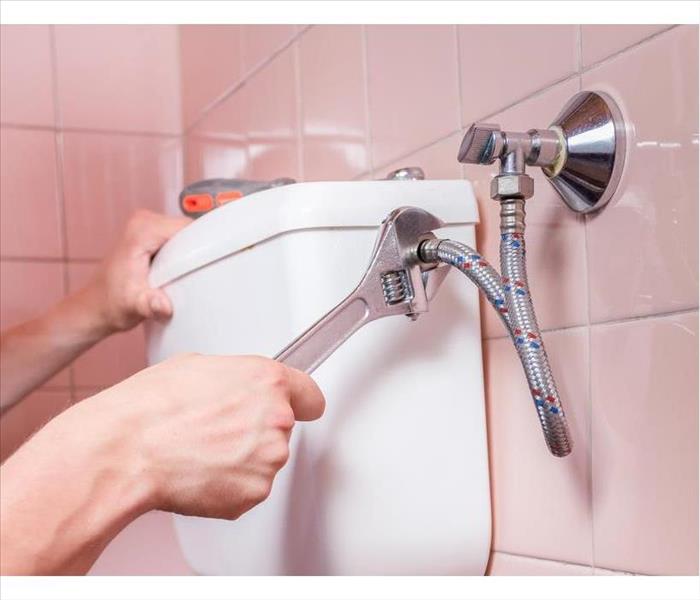 Repair leaking toilet tanks as soon as possible to prevent water damage in your home
Repair leaking toilet tanks as soon as possible to prevent water damage in your home
Learning the different ways that you can protect your house in Orlando, FL, from the ravages of water in home situations can spare you a good deal of inconvenience. A broken pipe can spew hundreds of gallons of water in a short time, and depending on its location, it can saturate not only your carpet and flooring but also your home’s structural materials. The good news is that leaks can often be prevented.
Water Damage Prevention Tips
The best option for avoiding the need for pipe cleanup is to prevent water from entering in the first place. The following list may offer you some guidelines in this matter:
- Check fittings and faucets and tighten or replace where needed
- Keep rooms warm during periods of extreme cold to prevent a broken pipe
- Use heat tape in unheated areas
- Repair leaking toilets as soon as possible
- Fix gaps in floors by tubs and showers where water may seep through
Why It Is Important To Avoid Leaks
A small leak can, over time, wreak havoc on the inside of cabinets, walls and flooring. A pipe burst, especially if it occurs when no one is at home, can produce great amounts of water, ruining flooring, sheetrock and other building materials. When the water in home damage comes from a toilet, contamination may also occur. A broken pipe will produce clean water but should not be left to sit, or mold and other bacteria may still occur.
Get Help If Needed
Using a professional water remediation service in Orlando, FL, is a good idea in either situation to ensure that water is extracted thoroughly and mold and bacteria are sufficiently cleaned up. They can help assess which items can be saved and which may need to be removed or replaced.
Leaking water in home pipe systems can cause a good deal of damage, but that does not need to be the case. If you inspect your plumbing regularly, keep pipes warm to prevent freezing and repair small leaks at the first sign of trouble, you may just prevent a catastrophe.
How To Recover From Water Damage Inside Your Home
8/21/2019 (Permalink)
 Flooded home in Orlando,FL
Flooded home in Orlando,FL
Coming home to discover that bursting pipes have caused your home in Orlando, FL, to be flooded can be an unwelcome surprise for almost anyone. After all, removing excess water may require professional intervention. This is because oftentimes, water may have pooled in difficult to reach areas or deep within carpeting and walls which can result in irreversible water damage to your home and possessions. Luckily, by enlisting the help of experts you can be on your way to making your flooded house feel like a home again.
Why It Happens
When unexpected flooding occurs inside the home, the cause is not always so obvious to the untrained eye. Water is constantly flowing or held in pipes throughout the home and when one of those bursts, it can wreak havoc inside your home. Some of the most common reasons for bursting pipes include the following:
- Corrosion due to regular wear and tear or expedited by an imbalance in water’s PH
- Water pressure that exceeds the recommended psi
- Pipes that are not installed or secured properly and damaged from excessive movement
The Recovery Process
While a skilled home handyman may be able to temporarily fix the issue, any extreme cases or long-term solutions may be better left to an experienced specialist who can correctly diagnose the issue, offer advice about how to prevent it from happening again and help with the recovery process. This can include adjusting your water pressure, checking your water’s composition, having to fix broken pipe equipment, system replacements not to mention recovery for any existing damage inside your home.
Being Prepared
It’s easy to think that large-scale water damage due to bursting pipes won’t happen in your home in Orlando, FL, until it does. By keeping the main causes of damage in mind, you can be proactive by properly caring for your pipes, checking your water pressure and ensuring your water is balanced. While it may take a bit of effort to do this, it can be worthwhile considering the inconvenience and costs of recovering from a flood.
Being Prepared for a Flood at a Residence
6/10/2019 (Permalink)
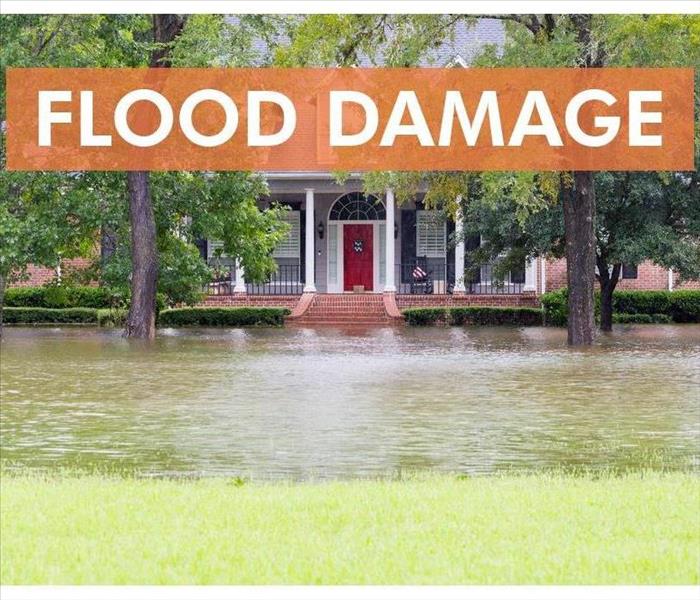 Flood in an Orlando, FL residence
Flood in an Orlando, FL residence
Ideas Homeowners and Residents May Consider in Order to Being Prepared for a Flood
Disasters can strike at any time, and it is important to be as prepared as possible for any unforeseen and troubling circumstances. A flood at a residence in Orlando, FL is an example of an event that could suddenly devastate a home, and there are certain steps that an individual can take to be ready if such a disaster strikes. Here are a couple of ideas that homeowners and residents may consider in order to be as prepared as possible.
1. Prepare the Family
Water damage may totally disrupt a family and their residence for an extended period. It may be a good idea to plan and take precautionary measures, such as creating an emergency plan for the family. This plan may include designating tasks for each family member to complete in the event of an emergency or deciding upon which important documents to keep secure and easily accessible in case an immediate evacuation is necessary. Additionally, an emergency bag may be a great idea to organize now. This “escape bag” can include essential items such as food and water to last for several days until professionals who specialize in repairing water damage can access the home.
2. Prepare the Home
A flood may occur for many reasons, including natural causes such as weather and storms, as well as something within the home like a broken pipe. If a homeowner has prepared his/her home for an emergency, this may significantly reduce the time that it could take to recover. Going through the home and making a list of preparations may save precious time. A homeowner may consider taking notes of any areas within the home that may need repair, and jot down tasks such as “fix broken pipe,” or “fix electrical outlets near the sink,” for instance. It may also be a good idea to explore the option of purchasing flood insurance coverage.
It is impossible to predict when a catastrophe may strike. However, if the family and the home are prepared, getting back to normal after a flood may be possible – and in a short amount of time!
Ways to Lower Your Business Interruption Insurance Loss
4/16/2019 (Permalink)
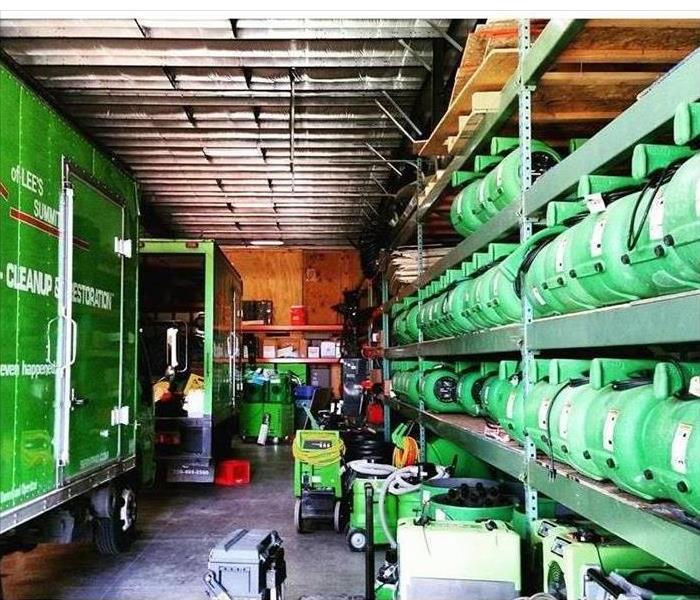 SERVPRO of SW Orlando can restore any residential or commercial building back to normal as quickly as possible.
SERVPRO of SW Orlando can restore any residential or commercial building back to normal as quickly as possible.
Can you imagine starting a business and not purchasing property insurance, fire insurance or other hazard coverage? It would be unwise to even consider go without these benefits. In the event of a disaster such as flooding, these plans could save you and your Orlando, FL, company from financial ruin. A severe emergency could make your building unusable and thus temporarily cease operations. Business interruption insurance is critical in these cases. There are ways to make sure your financial losses are minimal.
What It Covers
If you have to close your doors to your office due to large water damage, you could start to lose money and watch as customer jump ship and head over to your competitors. Business interruption insurance can help in the following ways:
- Compensates you for lost income if you have to leave the building and not conduct business
- Covers operating expenses such as electricity
- Covers the revenue you would have brought it had the disaster not occurred.
What Do You Do Next
If the flooding is extensive and shuts you down longer than you expected, your costs may exceed coverage limits. To avoid heavy losses, you may think things are out of your control. This will largely depend on how long it takes to clean up after the incident and make your building safe for work again. A quick recovery will help keep these losses down.
Hire the Right Help
This is where it’s critical to bring aboard an experienced, skilled flood restoration company. Whether it’s a broken pipe, sewer backup or other reason the water damage occurred, a competent team of professionals will move the recovery process forward more quickly. The crew will use the most advanced equipment and techniques to remove all water and then dry and sanitize the affected area.
If major flooding shuts down your business, make sure you hire the right cleanup team to get you back to work. This will help ensure the costs don’t exceed coverage limits.
Drip, Drip, Drip: How To Tell If Your Shower Is Leaking
3/29/2019 (Permalink)
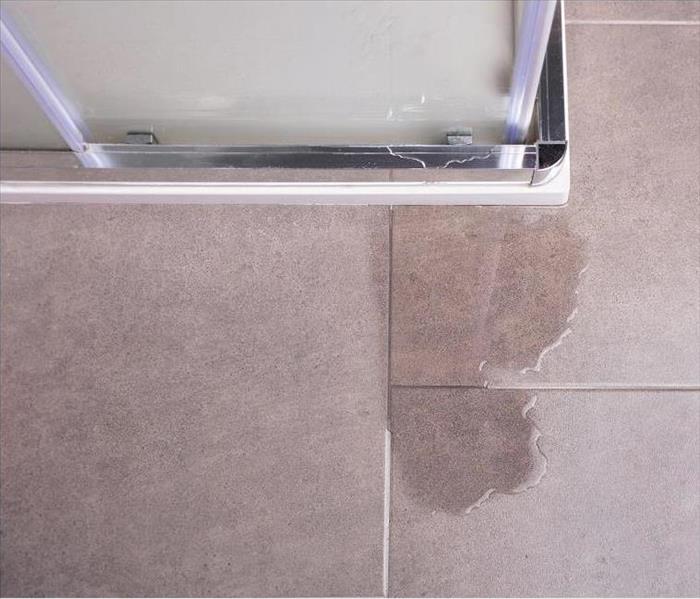 Shower leaking in a Orlando,FL home
Shower leaking in a Orlando,FL home
Water damage can be costly to the unsuspecting homeowner. In the fast pace of a daily routine, it can be difficult to remember to check for potential damage from something as mundane as a bathtub leak or shower pan leak. However, the earlier a leak is caught, the higher the chance that all you need is a simple repair.
How To Look for Damage
The first thing to do when looking for damage from a leak is to visually inspect the area. If you suspect a shower or bathtub leak, look for obvious signs of water damage:
- Look for any obvious cracks or damage to shower tile or the bathtub itself where it looks like water could be escaping.
- Peeling or loose trim can indicate potential damage from repeated water exposure.
- Check the faucet or shower head by running water for a short time and then turning the water off, observing any unusual water flow where the fixtures are attached to the wall.
- You may also be able to see issues with the threshold of a shower while the shower is on, such as water escaping when the shower doors are closed.
- Any stains in the ceiling directly underneath a bathroom are a definite red flag and need to be addressed as soon as possible.
What This Means for You
If you find any of these signs of possible leakage, it’s time to contact an emergency restoration professional. An experienced professional can not only prevent further structural damage from occurring around the bathtub but can also take steps to eliminate any mold or mildew buildup from trapped water.
Just remember, if you find any signs of a possible shower or bathtub leak in your bathroom, you can rest assured that a restoration professional in Orlando, FL, is Here to Help. Enlisting the aid or experienced professionals can help you get your home back to normal as quickly and as smoothly as possible.
Shut Off Valves at Work
10/29/2018 (Permalink)
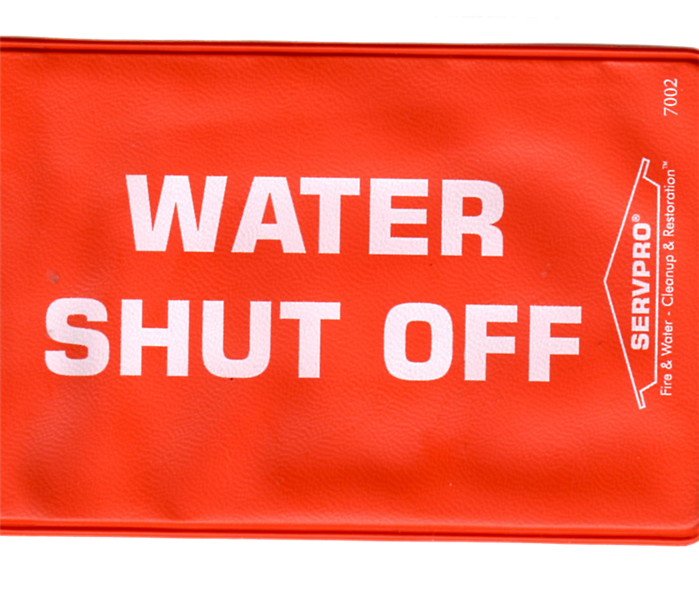 We also have shut off tags you can put on your water valves so they are easily noticeable.
We also have shut off tags you can put on your water valves so they are easily noticeable.
Many workplaces always call's on the boss or the maintenance man when something goes wrong. What if they were home sick, or in a meeting and you need to locate the water shut off, where do you start?
SERVPRO of SW Orlando can help commercial property in planning for a water, fire, storm damage. How, with a free Emergency Response Profile created by the SERVPRO Marketing Department.
By having a plan of action and including it into your regular training at your office you can minimize the cost if an unplanned event happens like a frozen pipe, fire, or anything.
Some property manager use this as a tool to keep everything organized in one central location.
Is your business ready for a disaster. Even a simple pipe burst can cause a lot of damage and headache. With a SERVPRO® Emergency READY Profile it can have the critical information to minimize damages, provide the resources for the employee's of the company, and provide property details and information. This is a FREE services that we provide to commercial properties.
Make an appointment today to get started!
If the unthinkable happens, call your local SERVPRO of SW Orlando Professionals at 407-704-0327; 24/7 to help you avoid the cost and hassle of secondary damages. We will help make it "Like it never even happened."
Orlando 24 Hour Emergency Water Damage Service
10/12/2018 (Permalink)
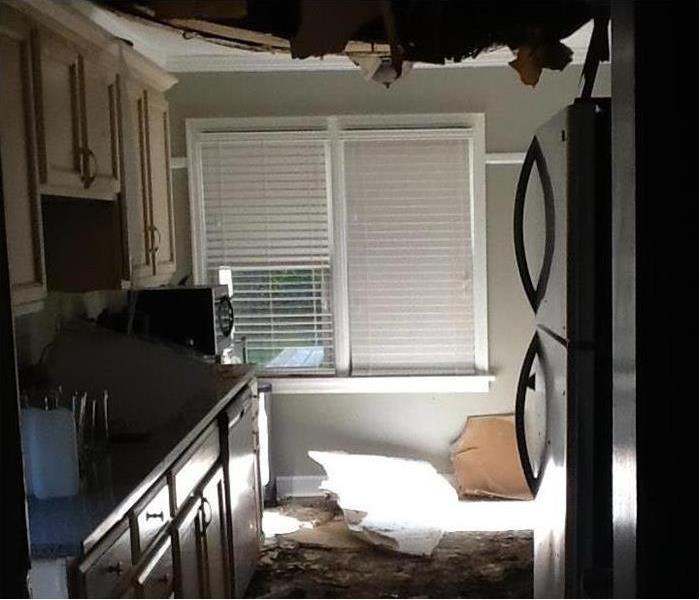 SERVPRO of SW Orlando provides 24 hour water damage restoration service in Orlando.
SERVPRO of SW Orlando provides 24 hour water damage restoration service in Orlando.
SERVPRO of SW Orlando is available 24 hours a day for water emergencies, large or small. When you are dealing with water damage, immediate action is crucial. A delay of just a few hours can greatly increase the severity of the water damage.
We Answer the Phone Ready to Help
Call Today - (407)704-0327
We understand that when you call us, you may be feeling confused, stressed, and vulnerable. You need an expert to guide you through this crisis. SERVPRO of SW Orlando has the specific water damage training and experience to help you through this tough time. We specialize in water damage restoration—in fact, it's the cornerstone of our business.
What to Expect
When you call, we will ask several questions regarding your water damage emergency. These questions will help us determine what equipment and resources to bring, including how many trained SERVPRO Professionals may be needed.
Our SERVPRO Representative will ask several questions:
- Your name and contact information
- Your insurance information (if applicable)
- The street address of the water-damaged home or business
- When did the flooding or water damage occur?
- What caused the water damage (if known)?
- Is there electricity available (on-site)?
About SERVPRO of SW Orlando
SERVPRO of SW Orlando specializes in the cleanup and restoration of residential and commercial property after a fire, smoke or water damage event. Our staff is highly trained in property damage restoration. From initial and ongoing training at SERVPRO’s corporate training facility to regular IICRC-industry certification, rest assured our staff is equipped with the knowledge to restore your property.
How SERVPRO Assesses Flood Damage After a Dishwasher Breakdowns in your Orlando Home
10/4/2018 (Permalink)
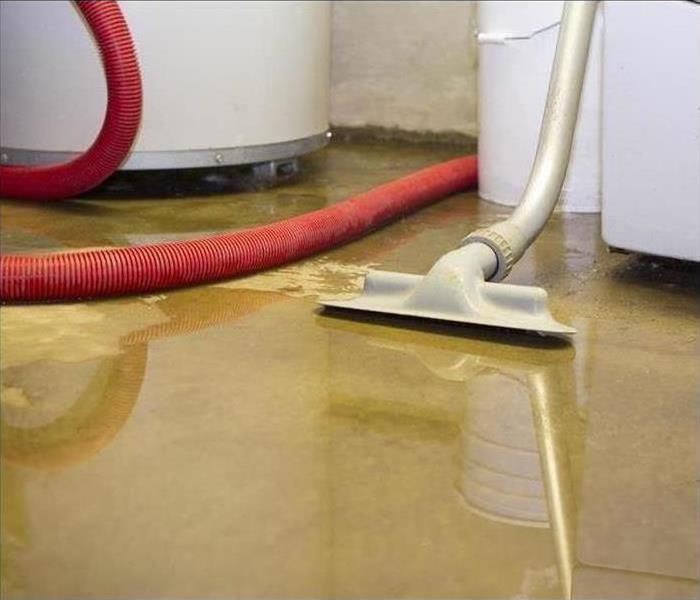 Orlando flooding relies on SERVPRO of SW Orlando for cleanup and water removal.
Orlando flooding relies on SERVPRO of SW Orlando for cleanup and water removal.
SERVPRO's Array of Measuring Devices Ensures a Dry Home Post Flooding
Dishwashers are a welcome addition to many households. After all, who does not love being able to simply rinse the dishes, set the cycle, and let the machine do the work? It is very convenient. However, like any other appliance, a dishwasher might malfunction, and a dishwasher breakdown often equals a flood of water in your kitchen.
Flood damage to your Orlando home can be a serious cause for concern. A dishwasher might cause a surprisingly large flood in your kitchen, so naturally, you want to get that cleaned up as quickly as possible to mitigate any further damage. That is why we recommend you put in a call to SERVPRO at once -We’re Faster To Any Size Disaster.
An essential element of our job is assessing the damage to your home. A thorough assessment lets our experts know how much moisture is present, which is vital information that we need to decide upon the best course of action.
A visual inspection is an important first start, but of course, that is only one part of the process. Our teams come prepared with a range of powerful equipment to help us assess the flood damage to your home:
A moisture sensor to help us ascertain how deeply water has penetrated into soft materials. The sensor displays a blinking light and makes an audible beep when moisture is present, and this allows us to measure the extent of the damage. We have other models that work silently.
A moisture meter to help us measure how much moisture is in any structure. Meters are useful for testing the damp content of every part surrounding your dishwasher including not only the floor but also walls, wall insulation, cabinets, and rugs or carpets. Do not worry if you have a wooden floor. Our SERVPRO experts also come equipped with penetrating moisture meters that can be used to take a reading under wood flooring or even inside the wall. Our technicians calibrate the instrument to suit the material that we are testing.
Thermo-hygrometers. Thermo-hygrometers measure the temperature and the relative humidity in your kitchen. Our technicians use these readings to determine the extent of the water damage. This is usually used after the water has been removed, a verification that a standard RH has been attained.
A complete evaluation of the situation assists us in drawing up an effective individual drying plan for your kitchen. We monitor moisture and humidity throughout the drying process so you can rest assured your kitchen is at optimum dryness and humidity before we call the job done. We can also provide documentation to your insurance company.
How to Prepare for Water Damage in 5 Steps
9/19/2018 (Permalink)
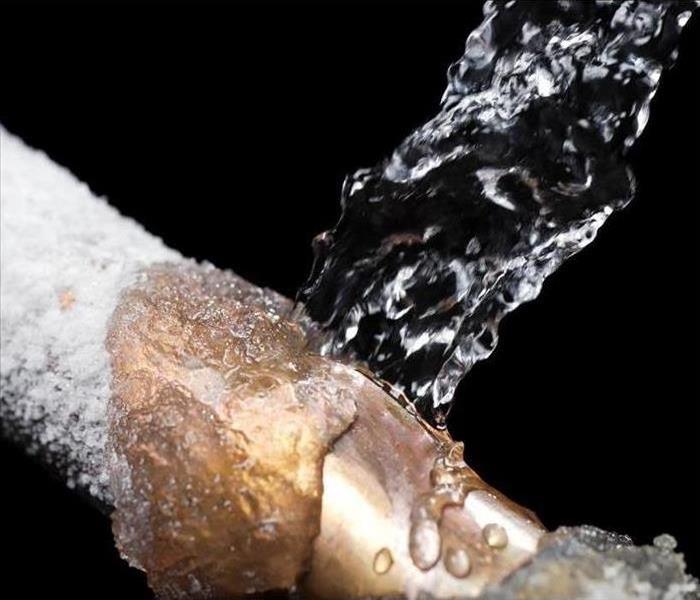 Call SERVPRO of Southwest Orlando today 407-704-0327
Call SERVPRO of Southwest Orlando today 407-704-0327
Most water damage that happens to your home is uncontrollable and unpredictable. It could potentially cost you thousands of dollars. When the water starts coming into your home, there is not much you can do to stop it but there is a couple things you can do to prepare for it. Here are a few steps you can take so you can be prepared for the worst.
Step 1: Stop the Source of the Water
If it is possible, stop the water at its source. If it has to do with your plumbing then turn off your water line as soon as possible. This will help with decreasing the amount of damage.
When the flooding occurs from storm water, there is no stopping a storm but you can try and divert the water away from your home by blocking entry points.
Step 2: Think Safety
If it safe, then shut off all electrical sources by turning the circuit breakers or unplug devices. Water and electricity don’t mix, remember that. Make sure everyone, including children, are away from standing water.
Step 3: Protect Your Possessions
Try and remove or raise your furniture from flood water. Water soaked furniture begin to mold very quick and you the last thing you will want is to throw away all of your belongings after a flood. Protect the things that are irreplaceable rather then carpet and other flooring.
Step 4: Contact Your Insurance Company
Now is the time to call your insurance and see how they will approach the water remediation. All insurance companies have professionals who specialize in this kind of emergency so they will have the best people to restore your home back to normal. Do not try to remove the water by yourself. You can just end up cause more damage.
Step 5: Work With the Professionals
When you are choosing a company to perform your water remediation; you need to compare everyone highs and lows. Make sure they have good reviews and are available at your earliest request. SERVPRO of Southwest Orlando is highly dependable and will exceed your expectations for your water remediation.
Do's & Don'ts of Water Damage
8/30/2018 (Permalink)
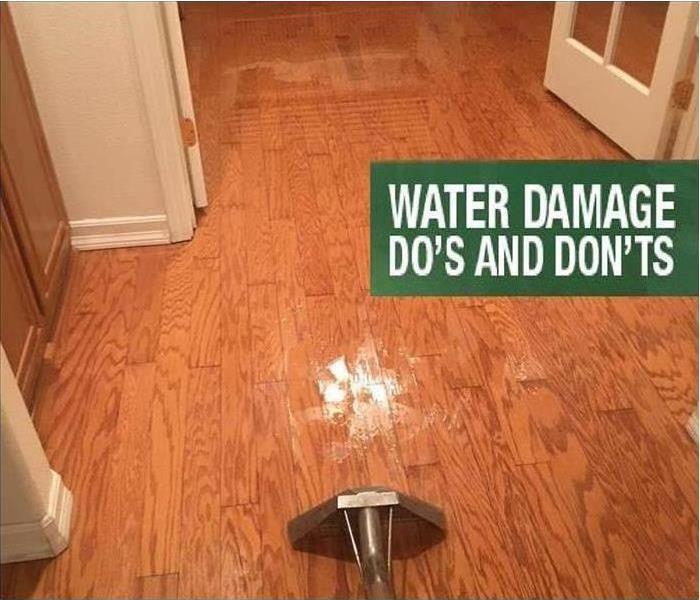 #SERVPRO #WaterDamage
#SERVPRO #WaterDamage
No one wants to come home to a flooded basement or to wake up to the sound of a broken pipe spraying water on valuable furniture and household possessions. However, the possibility of water damage occurring in your Southwest Orlando home is very real. Whether it is a pipe burst or a weather-related issue, it is important to arm yourself with some basic knowledge to deal with this type of emergency before it happens.
Here are a few tips to help in the event of water damage in your Florida home:
- First, ascertain whether it safe to stay in the house.
- Make sure there are no active electrical devices or outlets immersed in or near the water.
- Note that wet floors are slippery and “slip and fall” hazards are some of the most prevalent concerns.
- Keep in mind that wet materials can be VERY heavy.
- Have your plumber’s phone number ready and available.
- Contact your SERVPRO Professional at (407) 704-0327 for complete restoration.
While waiting for your SERVPRO Professional to reach your location, here is what you CAN do:
- Shut off the water
- Remove excess water by mopping and blotting.
- Wipe excess water from wood furniture after removal of lamps and tabletop items.
- Remove and prop wet upholstery and cushions.
- Place aluminum foil or wood blocks between furniture legs and wet carpeting.
- Turn air condition on for maximum drying in the Summer.
- Remove colored rugs from wet carpeting.
- Remove art objects and other prized possessions to a safe, dry place
- Gather loose items from floors.
What NOT to do After Flooding:
- Don't leave wet fabrics in place. Hang furs and leather goods.
- Don't leave books, magazines or other colored items on wet carpet or floors.
 If you do find water in light fixtures in your home, take it as a serious hint that some repair and cleanup are needed.
If you do find water in light fixtures in your home, take it as a serious hint that some repair and cleanup are needed.






 24/7 Emergency Service
24/7 Emergency Service














